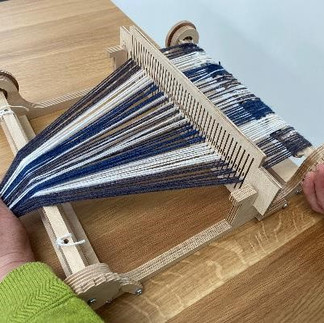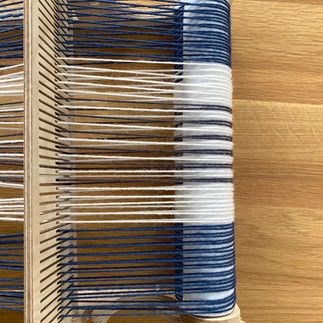What is one of the most common issues faced by weavers using a rigid heddle loom?
Our rigid heddle looms are most often purchased by new weavers who are looking to learn how to weave. Each loom comes with a scarf weaving kit and full instructions including step by step guidance with images. Like any new skill, weaving takes time and practise and thankfully in our experience most new weavers get on pretty well, even with their first weave. Where weaving issues arise with a rigid heddle loom they often centre around the setting up and warping of the loom. Often the questions we are asked centre on this step of the process. The two most common issues are (1) ensuring that the warp threads in the slots and the holes of the heddle separate well when weaving; and (2) achieving a uniform warp tension across the full width of the loom. Thankfully warping issues are often easily solved and this article seeks to address a number of problems with reasons and simple solutions.
Issue : -The warp threads in the holes and the slots don't separate when the heddle is moved up and down.
This common problem is often caused by a failure to use the warp winders on the right hand side of the loom to tighten the warp. New weavers often find it hard to gauge how far to tighten the warp threads. Our advice is to tighten the front winder first and to then tighten the back winder to get a good tension. The warp threads should feel taut and under tension. The heddle should still be able to be moved between the up and down positions (if the warp is too tight this will be difficult).
Poor separation between the warp threads in the slots and holes can occur with especially 'sticky yarns'. Wool in particular can be quite sticky and simply strumming the warp threads behind the heddle can help to separate them. An alternative solution is to take the heddle back to the back beam once before returning it to its normal weaving position either up or down.
Having the warp threads cross at the back of the loom can lead to poor separation too. So, when warping the loom, if you are changing the warp threads it is best to tie off the old thread and retie it onto the back warp stick if you need to use that thread again rather than bring it across the back warp stick.
Issue: The warp threads across the loom don't have the same tension, some threads are taut and others loose.
This is most likely an issue with winding the warp onto the back beam (beaming). Some people have a helper at this stage. If this is the case then your helper could hold the warp chains under tension for you as you wind them onto the back beam. I choose to warp my loom myself. To help with this I chain the warp threads as shown in the first image below. I can then wind the warp onto the back beam with my right hand whilst holding the warp threads under tension with my left hand as shown in the second image below. I have to release the tension frequently when each piece of paper is added onto the back beam (see next point below) and I use this opportunity the make sure that the warp threads are equally taut with no loose threads.
Using the paper on the back beam helps to separate the warp chains. Some weavers choose to use cardboard strips but personally I think it is easier to use paper, be it plain paper, brown paper or even old wallpaper. For my TabbyandTweed rigid heddle loom I use several pieces of A4 paper with about 1.5cm folded over on the short edge with the long edge then fully spanning the back beam. It is important to get the paper pieces in square to the back beam otherwise you will find that they crumple up at one of the sides.
Issue - the warp threads at the edges are very loose compared to the other warp threads.
This is again an issue with winding the warp onto the back beam. The most common problem being that the paper used was too small and didn't span the full width of the back beam. This then results in the outermost threads not going round the paper so travelling less distance around the beam. When weaving starts they will be tight as they will have been knotted tightly onto the front warp beam but as weaving takes place the outermost warp threads become looser and looser. If this occurs you might want to unwind the warp from the back beam and repeat the beaming process being more careful with respect to the paper positioning. Any weaving you have done will likely need to be sacrificed. One of the only ways we have identified to resolve this without sacrificing the weaving already done is to use small cardboard pieces on the back beam for the loose warp threads - far from ideal but semi successful if you want to finish the weaving on the loom without re-beaming.
It is our view that one of the key appeals of weaving is the journey of learning a new skill. We have made and solved lots of errors with our own weaving and we hope that the above strategies to solve some of the key problems faced commonly by weavers might be useful.
Rigid heddle looms with the scarf weaving kit to weave the scarf above are available in our TabbyandTweed website shop for UK delivery and our TabbyandTweed Etsy shop for delivery elsewhere. We sell a variety of scarf rigid heddle loom weaving kits which include the pattern and yarn for both 8epi and 10epi reeds.
Interested in learning to weave? Then our workshop page has all the details found by clicking the link here.
If you are interested in keeping up to date with our weaving work then do sign up to receive our newsletter by clicking the link here.



















